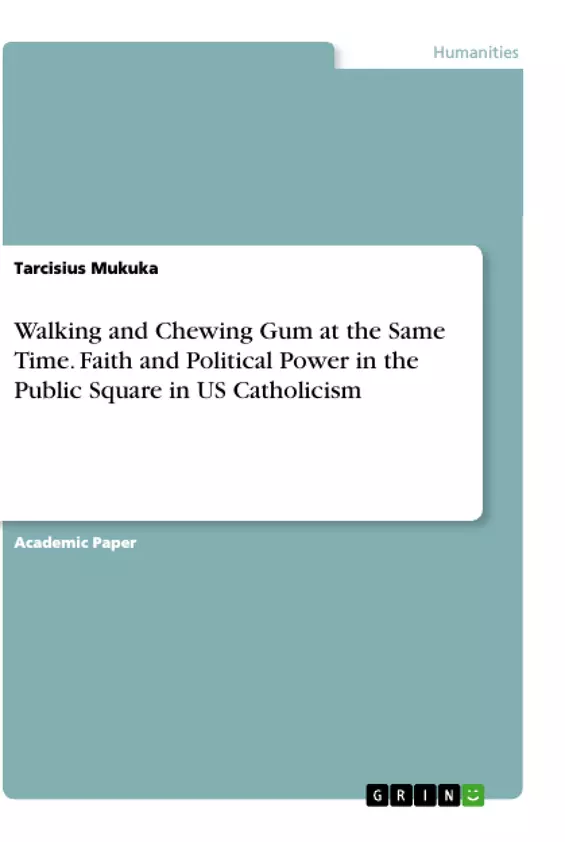This article examines the theological symbiosis or lack thereof between Joe Biden, Pope Francis and the US Catholic bishops. My argument is that Joe Biden and Pope Francis model authentic Catholic Social Teaching and faith in the public square, especially the former who, as a non-ecclesiastic doesn’t have to. I find the US Catholic bishops ambivalent. They talk a good game but walk an ambivalent one. I point to three examples: how they demonised Joe Biden during his campaign for the US presidency, canonised Donald Trump and how they have dealt with sexual abuse by priests, bishops and cardinals. In this latter case, I reluctantly agree with the views of a rogue Prince of the Church, Carlo Maria Viganò. The unusual triumvirate of Joe Biden, Pope Francis and the US Conference of Catholic Bishops which I examine here are held up to the litmus test of Catholic Social Teaching.
Inhaltsverzeichnis (Table of Contents)
- Introduction
- Democracy's Achilles' Heel in a Disunited States of America
- Political Theory, Politics of Power and Catholic Social Teaching
- Liberalism and its Critics
- Liberal Egalitarianism
- Communitarianism and Political Theory
Zielsetzung und Themenschwerpunkte (Objectives and Key Themes)
This article examines the intersection of political theory, politics of power and Catholic Social Teaching. The author, Dr Tarcisius Mukuka, explores the relationship between Joe Biden, the US Catholic bishops, and Pope Francis, using the lens of political science theory and Catholic Social Teaching. The article aims to demonstrate how these three figures operate within the political landscape and how their actions are informed by their respective beliefs and values.
- The role of faith and politics in the public square, particularly in the United States.
- The relationship between Joe Biden, Pope Francis, and the US Catholic bishops.
- The intersection of political theory, politics of power, and Catholic Social Teaching.
- The impact of state-sponsored terrorism on democracy.
- The vulnerability of democracy and its susceptibility to exploitation by terrorists.
Zusammenfassung der Kapitel (Chapter Summaries)
The introductory chapter explores the concept of "walking and chewing gum at the same time" as a metaphor for the complex relationship between faith and politics. It discusses the challenge faced by Joe Biden as a Catholic president in navigating the expectations of the American Catholic hierarchy regarding issues such as abortion and gay marriage.
Chapter 2 delves into the vulnerability of democracy in the face of terrorism. The author examines the arguments for and against democracy's ability to reduce or encourage terrorism, and presents the recent insurrection in the United States as evidence of the latter. He also discusses the role of state-sponsored terrorism and its impact on international relations.
Chapter 3 focuses on the intersection of political theory, politics of power, and Catholic Social Teaching. The author presents a summary of political theory, highlighting its contemporary themes and developments, with specific reference to Joe Biden, Pope Francis, and the US bishops.
Schlüsselwörter (Keywords)
The key focus of this article lies in exploring the interplay of faith, politics, and power in the context of US Catholicism. It examines the role of Catholic Social Teaching in shaping political discourse and its relevance in addressing contemporary challenges like state-sponsored terrorism, democracy's vulnerabilities, and the intersection of individual rights and social responsibility. Key terms include: Catholic Social Teaching, political theory, politics of power, Joe Biden, Pope Francis, US Catholic bishops, democracy, terrorism, state-sponsored terrorism, liberal egalitarianism, communitarianism, and human solidarity.
- Quote paper
- Dr Tarcisius Mukuka (Author), 2021, Walking and Chewing Gum at the Same Time. Faith and Political Power in the Public Square in US Catholicism, Munich, GRIN Verlag, https://www.grin.com/document/1126169



